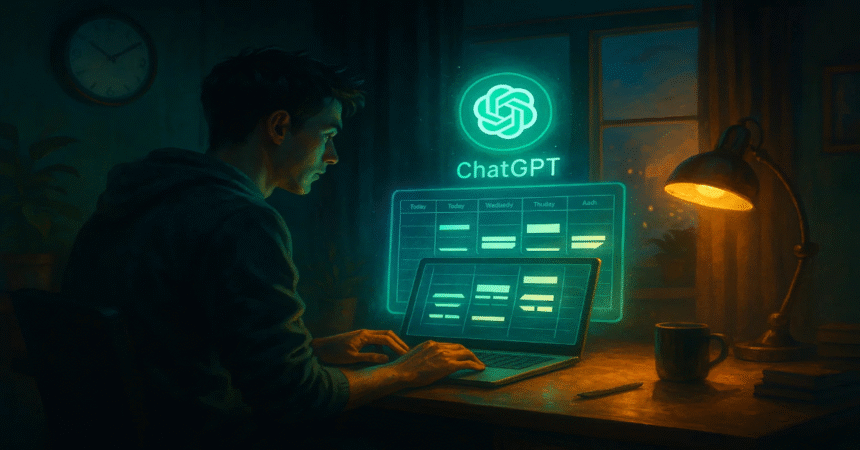ChatGPT and a Tired Developer Searching for Time
ChatGPT wasn’t just another AI tool for this developer. It became his way out of 80-hour weeks, endless bug fixes, and sprint planning that left him drained. At first, he doubted whether software like this could really change how he worked. But when deadlines piled up and his cloud backlog looked impossible, he tried a simple experiment with language prompts. What happened next turned his routine upside down.
- ChatGPT and a Tired Developer Searching for Time
- The Burnout Point Every Developer Recognizes
- Breaking Down Tasks With ChatGPT
- From Code Reviews to Clear Fixes
- Organizing Projects With AI Guidance
- Why He Switched to Chatronix
- The Prompts That Changed His Week
- Bonus Prompt for Developers
- Lessons From the Switch
- A Developer’s New Routine
- Why This Matters Beyond One Developer
- The Antidote to Burnout Culture
- The Ending He Didn’t Expect
The Burnout Point Every Developer Recognizes
He had reached the stage many developers know too well. The desk covered in sticky notes. Jira tickets piling up. Merge conflicts that ate hours of his nights. He wasn’t just tired — he was missing family dinners, skipping workouts, and constantly running on caffeine. That’s when the thought hit: what if I stop brute-forcing and start delegating to ChatGPT?
Breaking Down Tasks With ChatGPT
The first test was small:
- “Write a secure login function with JWT tokens in Node.js.”
- “Explain this error log like I’m five.”
The shock? It worked. Not just snippets of code but context, explanations, and structured fixes. Within days, he was using it for sprint estimates and bug triage. Work that previously took an afternoon collapsed into 30 minutes of guided output.
From Code Reviews to Clear Fixes
He then let ChatGPT act as a code reviewer. It flagged unused variables, spotted loops that could be optimized, and even suggested test coverage ideas. He realized that half of his late-night debugging was avoidable. ChatGPT didn’t replace human QA, but it acted like a teammate that never slept.
Organizing Projects With AI Guidance
The real productivity boost came when he stopped treating ChatGPT as a code generator and started using it as a project assistant.
Prompts like:
- “Turn this backlog into a two-week sprint plan with clear owners.”
- “Rank these tasks by priority and risk.”
- “Draft Slack updates for stakeholders with progress summaries.”
This wasn’t just about writing code faster — it was about reclaiming headspace. Suddenly, he was working on the project, not drowning inside it.
Why He Switched to Chatronix
Halfway through the journey, he realized ChatGPT alone wasn’t enough. He needed speed, variety, and comparison between different models. That’s when he discovered Chatronix, an AI workspace where six models sit in one chat.
Here’s what stood out for him:
- 10 free queries to test without risk
- Turbo mode for faster responses
- Quick side-by-side comparisons of Claude, Gemini, Grok, Perplexity and more
- One Perfect Answer feature – in turbo mode, it takes six outputs and fuses them into one best response. No scrolling through messy answers, just the most useful reply instantly
He told colleagues it felt like having six senior engineers in one room, but only one final voice giving the best answer. That was the leverage he needed.
👉 He pointed them to explore the full Chatronix turbo mode when they asked how he cut his workload in half.
Quick Comparison Table
| Tool | What It Gave Him | Time Saved |
| ChatGPT | Prompts, explanations, coding help | 10h/week |
| Claude | Polished writing for docs | 5h/week |
| Gemini | Research and summaries | 3h/week |
| Chatronix (Turbo) | One Perfect Answer + speed | 20h/week |
The Prompts That Changed His Week
He didn’t just ask random questions. He built a prompt system that delivered consistent results:
- “Summarize this pull request in plain English with risks highlighted.”
- “Turn this code comment into proper documentation.”
- “List three alternatives to this algorithm and rank by efficiency.”
- “Generate a troubleshooting checklist for memory leaks in Python.”
Each prompt saved 30–60 minutes. Stacked across dozens of tasks, that was two full days every week.
Bonus Prompt for Developers
“Explain this bug like a senior engineer would in a code review, then suggest three fixes ranked by risk.”
This became his go-to when production errors hit at the worst possible time. Instead of Slack panic, he had structured options on the table.
Lessons From the Switch
The shift wasn’t instant. He made mistakes:
- At first, he gave vague prompts. The answers were vague too.
- He tried to copy outputs blindly, only to find hidden issues.
- He forgot to fact-check when ChatGPT sounded too confident.
What changed was discipline. The more specific the language, the more reliable the output. The more he treated ChatGPT like a teammate instead of a vending machine, the better it worked.
A Developer’s New Routine
By month two, his schedule looked completely different:
Old week:
- 60h of coding + debugging
- 10h in meetings
- 10h documentation
New week with AI stack:
- 25h of coding with AI support
- 5h bug fixing
- 5h docs (auto-drafted)
- 10h actual planning & design
- 10h free time reclaimed
That “free time reclaimed” wasn’t Netflix hours. It was new features, rest, and family.
Why This Matters Beyond One Developer
The bigger story is that this isn’t just about one coder. Marketing teams are using the same stack for ad copy. Designers are prototyping faster with AI drafts. Startups are skipping consultants by comparing outputs across models.
The Antidote to Burnout Culture
For years, the default answer in tech was “work harder.” ChatGPT and especially Chatronix showed a different way: work smarter, offload more, and only do the human part. That’s the real story here.
10 Mind-Blowing Ways ChatGPT Can Be Your Personal Assistant and Save You 20+ Hours/Week (Thread) 👇 pic.twitter.com/V8bepr2iB5
— Muzahid Maruf (@muzahidmaruf01) August 14, 2025The Ending He Didn’t Expect
This developer thought he was fighting for deadlines. Instead, he ended up fighting for his life back. Less grind. More focus. Real weekends. His verdict? AI is not hype when it’s this practical.
And the kicker: it isn’t locked to a genius coder. Anyone willing to write better prompts can replicate it. That’s why his story resonates — because every developer knows what it’s like to be drowning in tickets. Now they know there’s a lifeline.














